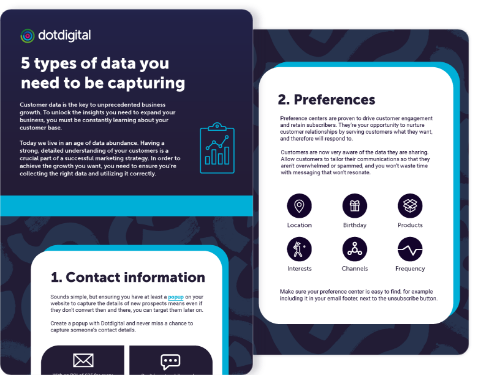

Understanding what your customers want

The key foundation for every business is a customer need. If there wasn’t a need, there wouldn’t be a market, and then there wouldn’t be a business. So, how can you ensure you’re accurately interpreting, and serving that need. Well as the saying goes, what four letter word makes the world go round? Ah yes, data.
Data is crucial to the success of your marketing strategy, it allows you to tap into your customer’s psyche and behavior, to identify what makes them tick and therefore, convert.
Data covers a whole host of opportunities, so let’s break it down.
What is customer data?
Customer data is the information you collect on your customer base throughout your relationship with them. In an age of data abundance, you need to ensure you’re collecting the right data, and then utilizing it correctly to create growth opportunities and implement strategies which lead to conversions.
Most customer data you collect will fall into one of two categories:
1. Zero-party data:
This is data you ask your customers to provide, whether that’s in a sign up form or preference center, for example:
– Name
– Email address
– Phone number
– Age
– Location
– Job title
– Interests
2. Behavioral data:
This is data which you record when a customer interacts with your business, for example:
– Browsing history
– Email clicks
– Past purchases
– Abandoned cart or browses
– Average order value (AOV)
Why is collecting customer data important?
Collecting customer data allows you to build detailed and insightful customer profiles which then allow you to tailor your marketing, leading to much more effective and efficient campaigns.
By collecting customer data and utilizing it accurately, you will not only improve the likelihood of a conversion thanks to relevant and timely content, but also reduce the number of unnecessary and irrelevant communications you send out, which at best will bore your subscriber, and at worst, lead to an unsubscribe.
Data collection informs your marketing. A lot of digital marketing relies on tests, seeing what works and what doesn’t, but with email marketing, you’re able to ask your customers what they want and also see what they respond to. This knowledge is power, it allows you to serve your customers exactly what they want, before they even realize it themselves.
What can you do with customer data?
Personal data
Collecting personal data is essential for personalization. By collecting something as simple as a name, you’re able to address them individually, and create a stronger relationship. 66% of consumers say that content that isn’t personalized would stop them from making a purchase.
Customers are increasingly cautious about handing over their data, so by creating personalized and relevant communications, which make your customers’ lives easier, you are demonstrating a value exchange in return for sharing their data with you.
The number one benefit of personalized experiences is that they delight the customer and create a stronger relationship between your customer and your brand. As a result, they’ll return to your brand because you have provided them with a superior experience.

Jewelry brand, Monica Vinader, team basic first name personalization with intelligent dynamic images to deliver a simple message with impact.
Segmenting your data
You need data such as location, job title, and interests to accurately segment your audiences.
Segmentation goes hand in hand with personalization. It allows you to target large groups at once, while still delivering specific content that’ll engage those readers and lead to conversions.
An example is a fashion brand could create a segment of customers who they know have a preference for a specific category, in this instance, let’s say dresses. By grouping together all of those customers and prospects that they know are interested in dresses – whether they know this from asking customers in a preference center, or from behavioral data – this segment would be great to target with an email focused on dresses. Similarly, B2B brands could segment based on authority level. Collecting job titles to identify budget holders and decision-makers to create a segment, ready to send relevant messages to.
Once you have segments identified, you can either create specific campaigns targeting individual preferences, or you can create a single campaign and use dynamic content blocks to personalize for each segment.
The bigger and more diverse your offering is, the more vital data gathering is. Large businesses such as department stores need to be driving customers to update their preference centers. Doing this regularly will ensure customer demands are being met and you’re not sending campaigns to customers who have no interest in the content, leading to an unsubscribe.


Behavioral data
Unlike zero-party data, behavioral data doesn’t rely on a customer to share it, it’s generated directly from a customer’s engagement activity with your brand. Behavioral data is both insightful and reliable as this data will be sourced straight from your website, CRM and ecommerce systems, and marketing automation platforms.
Behavioral data gives you a wealth of information, utilize it correctly in your marketing strategy and you’ll soon see conversions increase. An example of this is a triggered automation campaign which targets those shoppers who have browsed, but not bought, with an abandoned browse campaign. Remind them what they were looking at, showcase similar alternatives, and even utilize RFM modelling to determine if this particular customer will need a discount to get them over the line and convert.

Cosmetics brand, Tarte, add smart product recommendations as part of its abandoned browse campaign. By teaming a recommendation block with its trigger recovery campaign, Tarte are increasing the chances of shoppers’ adding more items to their shopping carts.
Keeping a close eye on your customers’ behavior will reveal untapped data that can power-up your marketing campaigns and increase conversion.
Contents
Natasha Lainsbury

5 types of data you need to be capturing
We’re sharing 5 types of essential data you should be capturing, plus how to capture and use it effectively to better inform your marketing campaigns and achieve your goals.
Get your copyStay on top
Get the latest and greatest marketing insight delivered to you weekly
Your email address will be handled in accordance with our Privacy Policy. We gather data around email opens & clicks using standard technologies including clear gifs to help us monitor and improve our newsletter.

